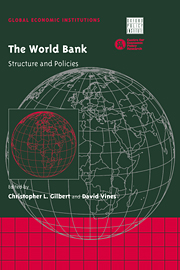Book contents
- Frontmatter
- Contents
- List of figures
- List of tables
- List of contributors
- Acknowledgements
- Introduction
- 1 The World Bank: an overview of some major issues
- Part One The World Bank's Structure: The Bank as an Institution
- 2 Positioning the World Bank
- 3 The World Bank and poverty reduction: past, present and future
- 4 Why the World Bank should be involved in development research
- 5 The challenges of multilateralism and governance
- Part Two The Effectiveness of World Bank Assistance
- Index
2 - Positioning the World Bank
Published online by Cambridge University Press: 12 October 2009
- Frontmatter
- Contents
- List of figures
- List of tables
- List of contributors
- Acknowledgements
- Introduction
- 1 The World Bank: an overview of some major issues
- Part One The World Bank's Structure: The Bank as an Institution
- 2 Positioning the World Bank
- 3 The World Bank and poverty reduction: past, present and future
- 4 Why the World Bank should be involved in development research
- 5 The challenges of multilateralism and governance
- Part Two The Effectiveness of World Bank Assistance
- Index
Summary
Introduction and summary
The World Bank (henceforth ‘the Bank’) is dedicated to the promotion, world-wide, of sustainable economic development and poverty reduction. It pursues these objectives through lending, through the production of research and the provision of economic analysis, and through policy advice and technical assistance.
The initial rationale for the Bank was that a source of lending, in support of the objective of economic development, was justified by market failures in the international capital market. We argue that this justification can no longer be sustained. Our justification for the existence of an institution like the Bank dedicated to poverty reduction, is, instead, that it can help to resolve global market failures in the development process. As a consequence, we identify three key ‘rationales’ for the Bank: the rectification of government failure, the rectification of information failures and the provision of global public goods. But we also believe that a Bank with these rationales needs to reposition itself.
The Bank is a complex organisation; a continuing line of criticism has been that it is too sprawlingly complex. Oliver's (1971, 1975) accounts of the Bretton Woods and subsequent negotiations show that differences of opinion about how the Bank should pursue its central objective, both between the Americans and the British, and also within the US administration itself go right back to the Bank's very origins. Nairn (1994) accuses current World Bank practices of generating dysfunctional ‘goal congestion’. The implication of a long line of such criticism (see KLW, 1997a, chapter 14) is that it might be desirable if the Bank could better define its focus. We agree.
- Type
- Chapter
- Information
- The World BankStructure and Policies, pp. 39 - 86Publisher: Cambridge University PressPrint publication year: 2000
- 4
- Cited by

